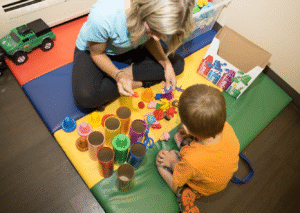Sensory processing disorder, SPD is a neurological condition in which multi-sensory input in not adequately processed. Recognized as one of the most common chronic neurological disabilities in school-aged children, SPD can also affect adults if not properly diagnosed early. Since SPD can be hard to diagnose the actual number of children reported to have SPD is lower than the actual number that have it. Parents usually recognize SPD, also known as sensory integration dysfunction, during the toddler years, though it can appear at different ages. The symptoms can range from mild to severe and can affect some or all of the five classic senses including vision, auditory (sound), touch, olfactory (smell) and taste. Some children show hypersensitivity or become overly sensitive to sounds, textures, tastes, smells, sights, and feelings, while others struggle to complete everyday tasks because their senses overwhelm them.
Symptoms of Sensory Processing Disorder
Symptoms of sensory processing disorder are hard to identify because they are so diverse and require a comprehensive sensory integration evaluation that is usually performed by an Occupational therapist. If you have concerns about whether your child has a sensory processing disorder, a good place to start is your pediatrician that will then refer your child out to an occupational therapist for further evaluation.
Sensory Processing disorder is made up of three categories, sensory modulation disorder, sensory-based motor disorder and sensory discrimination disorder. The characteristics of these differ and therefore further investigation is needed by a trained professional to distinguish between the type your child may have. Some common signs that your child may have sensory processing disorder include:
- Aversions (for example, refuses to wear specific clothing types or texture of clothing) and over-sensitivities to loud sounds
- Easily distracted by noises. This is usually observed with school-aged children
- Oversensitivity or decreased sensitivity to pain, temperature, or touch
- Difficulty transitioning from one activity to another
- Difficulty falling asleep or staying asleep
- Difficulty with eye contract
- Craving excessive movement (for example jumping excessively on beds or furniture)
- Frequently dropping things or falling frequently
- Being afraid of heights or swings
- Difficulty following multi-step directions
- Strong desire for sameness or routine in their daily life
- Poor handwriting
Sensory integration dysfunction can make a child feel different from their peers which may lead to social isolation, tantrums, frustration and other behavioral issues.
After performing a sensory integration evaluation, an occupational therapist provides recommendations for accommodations to support the child or adult in their daily life.

Sensory Processing Disorder Treatment
Treatment for children with sensor processing disorder involves a multidisciplinary approach and may include physical, occupational and speech therapy. The therapist helps the child respond to the sensory stimulus in a more functional way through different therapies. Parents and teachers can also impact this process by being attentive to the child’s needs and for making accommodations based on the therapist’s recommendations at home that help the child to self-regulate for activities of daily living.
If you think your child may have a sensory processing disorder, it is important to let your pediatrician know so that they can refer them for a sensory integration evaluation. If the evaluation confirms that they have a sensory processing disorder, there are many treatment options available for parents and teachers to make the child successful both at home and at school.
Check out our sensory processing therapy.




